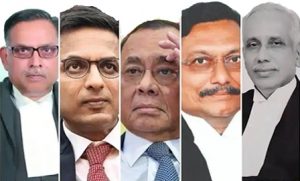Ayodhya Verdict: SC Unanimously Awards Disputed Site for Ram Temple
Supreme Court orders that the disputed land must be given to a Board of Trustees for the construction of Ram Mandir. Moreover, as a relief, an alternate and suitable land must be given to Sunni Waqf Board.

The Supreme Court, in a unanimous judgement on Saturday, allocated 2.77 acres of disputed Ayodhya plot to construct a temple. The court ruled that the disputed land must be given to a Board of Trustees within three months for construction of the temple.
On the other hand, the court ruled to allocate a separate plot of five acres of a ‘prominent site’ to Muslims for the construction of a mosque. This will be done either by the State or Central government.
The five-judge Constitution bench delivered its judgement on the cross-petitions filed by Hindu and Muslim sides, challenging Allahabad High Court Judgement, which ruled the three-way partition of the disputed land among Ram Lalla, the Nirmohi Akhara and the Sunni Waqf Board in 2010.
The bench stating that HC judgement of partition defies logic denied any claim or managerial rights to Nirmohi Akhara. The SC bench comprised of Chief Justice of India Ranjan Gogoi, Justices S. A. Bobde, D. Y. Chandrachud, Ashok Bhushan and S. Abdul Nazeer.
ASI Findings & AIMPLB’s Objection
Among other things, the apex court based the judgement on the Archaeological Survey of India (ASI) findings. The court citing ASI said that Babri Masjid was constructed after demolishing an underlying structure, which was not Islamic. However, it observed that ASI did not confirm whether the mosque was built after demolishing a Hindu Temple.

Citing documentary evidence, the court stated that prior to 1857, there was no exclusion of Hindus from worshipping at the site. ‘The evidence indicates that despite the existence of a mosque at the site, Hindu worship at the place, believed to be the birth-place of Lord Ram, was not restricted. The existence of an Islamic structure at a place considered sacrosanct by the Hindus did not stop them from continuing their worship at the disputed site and within the precincts of the structure prior to the incidents of 1856–57’, states the verdict.
‘On the other hand, learned counsel fairly stated that the evidence relied on by the Sunni Central Waqf Board to establish the offering of namaz by the Muslim residents commenced from around 1856–57’, it further reads.
The court stated that there is clear evidence that Hindus worshipped in the outer Courtyard. However, with regards to the inner Courtyard, where the mosque was built, there is no evidence by Muslims to show their exclusive possession prior to 1857.
After the 1934 riots, the possession of inner courtyard became a matter of serious contention and Muslims have failed to establish proof of possessory title, said the bench. However, there is evidence that shows that Muslims did not abandon the mosque, the court added.
Also Read : Artificial Intelligence The Solution To Reducing Backlogs In Indian Courts
All India Muslim Personal Law Board (AIMPLB) secretary Zafaryab Jilani expressed dissatisfaction. Jilani, addressing the media outside the Supreme Court, said, ‘We are dissatisfied that the inner courtyard where prayers were offered was given to the other side. Neither equity nor justice has been served’.
He further said, ‘As per the Sharia law, we cannot give away a mosque; however, we will abide by the court’s verdict. There is no evidence on what happened on that land between the 12th century and 1528. The Hindus claim that the temple was present since the Vikramaditya era but there is no evidence that proves it’.
As stated in the verdict, ‘Between the twelfth century to which the underlying structure is dated and the construction of the mosque in the sixteenth century, there is an intervening period of four centuries. No evidence has been placed on the record in relation to the course of human history between the twelfth and sixteen centuries’.
The court also stated that the faith of the Hindus that Lord Ram was born at the demolished site is undisputed. It cited the existence of Ram Chabutra, SitaRasoi and Bhandargirh as the testimony of the religious fact of the place. However, the bench said that the title cannot be established on the ground of faith and belief.
